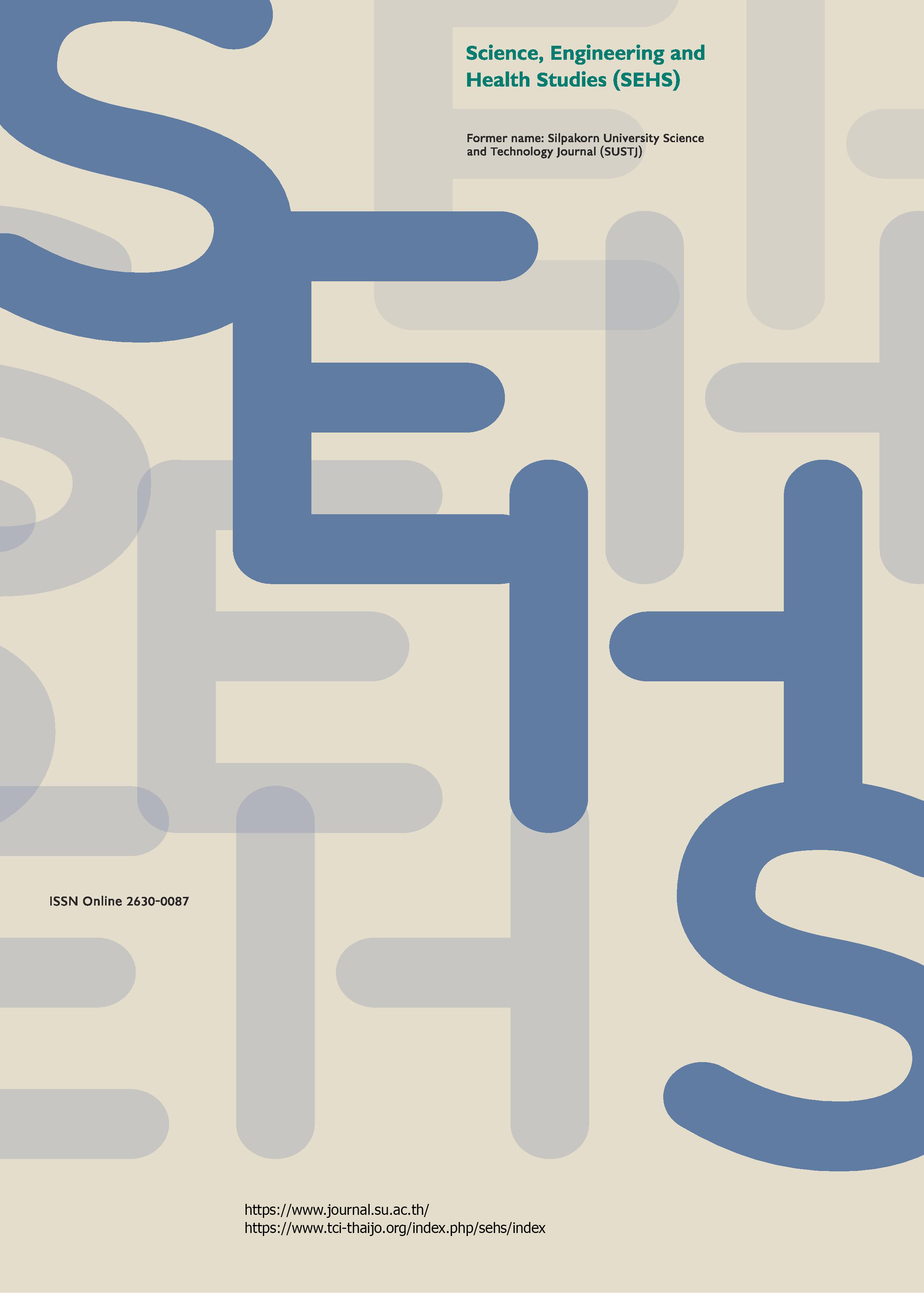Life cycle assessment on alternative hydrogen production for greener technology
Main Article Content
Abstract
Hydrogen has been recognized as an alternative energy carrier and one of the future fuels in the global transition to clean energy. Hydrogen production with net-zero-carbon emissions has been developed because steam methane reforming, as a conventional means of hydrogen production, involves carbon dioxide emissions. This study carried out a life cycle impact assessment of conventional hydrogen production and compared the outcomes to two other zero-carbon emission technologies: proton exchange membrane electrolysis and methane pyrolysis. Main inventory data collection was based on process simulation and impact assessment using the Aspen plus V12.0 and Simapro 9.1 software packages, respectively. The system boundary involved gate-to-gate consideration with electricity supply from Thailand’s grid mix and a functional unit of 1,000 kg/h hydrogen production. The ReCiPe 2016 midpoint impact assessment method was used to evaluate five impact categories: global warming potential, freshwater and marine ecotoxicity, and human carcinogenic and non-carcinogenic toxicity. In terms of global warming potential, proton exchange membrane electrolysis was 1.7 times higher than steam methane reforming and 2.3 times higher than methane pyrolysis, since its primary energy is derived from fossil-based electricity. Although methane pyrolysis relied on hydrocarbon feedstock, it had the lowest environmental impact in all five impact categories investigated.
Downloads
Article Details

This work is licensed under a Creative Commons Attribution-NonCommercial-NoDerivatives 4.0 International License.
References
Alizadeh, S. M., Ghazanfari, A., Ehyaei, M. A., Ahmadi, A., Jamali, D. H., Nedaei, N., and Davarpanah, A. (2020). Investigation the integration of heliostat solar receiver to gas and combined cycles by energy, exergy, and economic point of views. Applied Sciences, 10(15), 5307.
Amran, U. I., Ahmad, A., and Othman, M. R. (2017). Life cycle assessment of simulated hydrogen production by methane steam reforming. Australian Journal of Basic and Applied Sciences, 11(3 Special), 43–50.
Ansari, D., Grinschgl, J., and Pepe, J. M. (2022). Electrolysers for the hydrogen revolution: Challenges, dependencies, and solutions. SWP Comment, 57, 8.
Banu, A., Mohamed, A. A. H., Abushaikha, A. S., and Bicer, Y. J. E. R. (2022). Thermodynamic assessment of a hybrid methane cracking system for liquified hydrogen production and enhanced oil recovery using CO2. Energy Reports, 8, 13780–13792.
Crippa, M., Guizzardi, D., Pagani, F., Banja, M., Muntean, M., Schaaf, E., Becker, W., Monforti-Ferrario, F., Quadrelli, R., Risquez Martin, A., Taghavi-Moharamli, P., Köykkä, J., Grassi, G., Rossi, S., Brandao De Melo, J., Oom, D., Branco, A., San-Miguel, J., and Vignati, E. (2023). GHG Emissions of All World Countries – 2023, Luxembourg: Publications Office of the European Union.
Delbeke, J., Runge-Metzger, A., Slingenberg, Y., and Werksman, J. (2019). The Paris Agreement. In Towards a Climate-Neutral Europe (Delbeke, J., and Vis, P., Eds.), New York: Routledge, pp. 24–45.
Dickinson, R. E., Meleshko, V., Randall, D., Sarachik, E., Silva-Dias, R., and Slingo, A. (1996). Climate processes. In Climate Change 1995: The Science of Climate Change (Houghton, J. T., Meira Filho, L. G., Callander, B. A., Harris, N., Kattenberg, A., and Maskell, K., Eds.), pp. 193–227. Cambridge, Great Britain: Cambridge University Press.
Huijbregts, M. A. J., Steinmann, Z. J. N., Elshout, P. M. F., Stam, G., Verones, F., Vieira, M., Zijp, M., Hollander, A., and van Zelm, R. (2017). ReCiPe2016: A harmonised life cycle impact assessment method at midpoint and endpoint level. The International Journal of Life Cycle Assessment, 22(2), 138–147.
International Energy Agency. (2019). The Future of Hydrogen: Seizing Today’s Opportunities. IEA. Online URL: https://iea.blob.core.windows.net/assets/9e3a3493-b9a6-4b7d-b499-7ca48e357561/The_Future_of_Hydrogen.pdf] accessed on February 7, 2024.
Keipi, T., Tolvanen, H., and Konttinen, J. (2018). Economic analysis of hydrogen production by methane thermal decomposition: Comparison to competing technologies. Energy Conversion and Management, 159, 264–273.
Kojima, H., Nagasawa, K., Todoroki, N., Ito, Y., Matsui, T., and Nakajima, R. (2023). Influence of renewable energy power fluctuations on water electrolysis for green hydrogen production. International Journal of Hydrogen Energy, 48(12), 4572–4593.
Machhammer, O., Bode, A., and Hormuth, W. (2016). Financial and ecological evaluation of hydrogen production processes on large scale. Chemical Engineering and Technology, 39(6), 1185–1193.
Mehmeti, A., Angelis-Dimakis, A., Arampatzis, G., McPhail, S. J., and Ulgiati, S. (2018). Life cycle assessment and water footprint of hydrogen production methods: From conventional to emerging technologies. Environments, 5(2), 24.
Muazzam, Y., Yousaf, M., Zaman, M., Elkamel, A., Mahmood, A., Rizwan, M., and Adnan, M. (2022). Thermo-economic analysis of integrated hydrogen, methanol and dimethyl ether production using water electrolyzed hydrogen. Resources, 11(10), 85.
Noyan, O. F., Hasan, M. M., and Pala, N. (2023). A global review of the hydrogen energy eco-system. Energies, 16(3), 1484.
Office of Natural Resources and Environmental Policy and Planning. (2022). Thailand’s Long-Term Low Greenhouse Gas Emissions Development Strategy (Revised Version). Climate Change Management and Coordination Division. [Online URL: https://unfccc.int/sites/default/files/resource/Thailand%20LT-LEDS%20%28Revised%20Version%29_08Nov2022.pdf] accessed on February 7, 2024.
Osman, A. I., Mehta, N., Elgarahy, A. M., Hefny, M., Al-Hinai, A., Al-Muhtaseb, A. H., and Rooney, D. W. (2022). Hydrogen production, storage, utilisation and environmental impacts: A review. Environmental Chemistry Letters, 20, 153–188.
Phan, T. S., Minh, D. P., Espitalier, F., Nzihou, A., and Grouset, D. (2022). Hydrogen production from biogas: process optimization using ASPEN Plus®. International Journal of Hydrogen Energy, 47(100), 42027–42039.
Sánchez‐Bastardo, N., Schlögl, R., and Ruland, H. (2020). Methane pyrolysis for CO2‐free H2 production: A green process to overcome renewable energies unsteadiness. Chemie Ingenieur Technik, 92(10), 1596–1609.
Sánchez-Bastardo, N., Schlögl, R., and Ruland, H. (2021). Methane pyrolysis for zero-emission hydrogen production: A potential bridge technology from fossil fuels to a renewable and sustainable hydrogen economy. Industrial and Engineering Chemistry Research, 60(32), 11855-11881.
Schneider, S., Bajohr, S., Graf, F., and Kolb, T. (2020). State of the art of hydrogen production via pyrolysis of natural gas. ChemBioEng Reviews, 7(5), 150–158.
The Engineering ToolBox. (2003). Fuels - higher and lower calorific values. The Engineering ToolBox. [Online URL: https://www.engineeringtoolbox.com/fuels-higher-calorific-values-d_169.html] accessed on February 7, 2024.
Wang, T., Cao, X., and Jiao, L. (2022). PEM water electrolysis for hydrogen production: Fundamentals, advances, and prospects. Carbon Neutrality, 1(1), 21.

